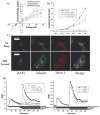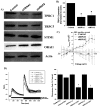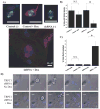Disruption of transient receptor potential canonical channel 1 causes incomplete cytokinesis and slows the growth of human malignant gliomas
- PMID: 20544850
- PMCID: PMC3685186
- DOI: 10.1002/glia.20994
Disruption of transient receptor potential canonical channel 1 causes incomplete cytokinesis and slows the growth of human malignant gliomas
Abstract
Despite decades of research, primary brain tumors, gliomas, lack effective treatment options and present a huge clinical challenge. Particularly, the most malignant subtype, Glioblastoma multiforme, proliferates extensively and cells often undergo incomplete cell divisions, resulting in multinucleated cells. We now present evidence that multinucleated glioma cells result from the functional loss of transient receptor potential canonical 1 (TRPC1) channels, plasma membrane proteins involved in agonist-induced calcium entry and reloading of intracellular Ca(2+) stores. Pharmacological inhibition or shRNA mediated suppression of TRPC1 causes loss of functional channels and store-operated calcium entry in D54MG glioma cells. This is associated with reduced cell proliferation and, frequently, with incomplete cell division. The resulting multinucleated cells are reminiscent of those found in patient biopsies. In a flank tumor model, tumor size was significantly decreased when TRPC1 expression was disrupted using a doxycycline inducible shRNA knockdown approach. These results suggest that TRPC1 channels play an important role in glioma cell division most likely by regulating calcium signaling during cytokinesis.
(c) 2010 Wiley-Liss, Inc.
Figures







Similar articles
-
Transient receptor potential canonical channels are essential for chemotactic migration of human malignant gliomas.J Cell Physiol. 2011 Jul;226(7):1879-88. doi: 10.1002/jcp.22518. J Cell Physiol. 2011. PMID: 21506118 Free PMC article.
-
A TRPC1-mediated increase in store-operated Ca2+ entry is required for the proliferation of adult hippocampal neural progenitor cells.Cell Calcium. 2012 Jun;51(6):486-96. doi: 10.1016/j.ceca.2012.04.014. Epub 2012 May 11. Cell Calcium. 2012. PMID: 22579301
-
Inhibition of transient receptor potential canonical channels impairs cytokinesis in human malignant gliomas.Cell Prolif. 2008 Feb;41(1):98-121. doi: 10.1111/j.1365-2184.2007.00504.x. Cell Prolif. 2008. PMID: 18211288 Free PMC article.
-
STIM-TRP Pathways and Microdomain Organization: Contribution of TRPC1 in Store-Operated Ca2+ Entry: Impact on Ca2+ Signaling and Cell Function.Adv Exp Med Biol. 2017;993:159-188. doi: 10.1007/978-3-319-57732-6_9. Adv Exp Med Biol. 2017. PMID: 28900914 Review.
-
New Aspects of the Contribution of ER to SOCE Regulation: TRPC Proteins as a Link Between Plasma Membrane Ion Transport and Intracellular Ca2+ Stores.Adv Exp Med Biol. 2017;993:239-255. doi: 10.1007/978-3-319-57732-6_13. Adv Exp Med Biol. 2017. PMID: 28900918 Review.
Cited by
-
Development of Store-Operated Calcium Entry-Targeted Compounds in Cancer.Front Pharmacol. 2021 May 28;12:688244. doi: 10.3389/fphar.2021.688244. eCollection 2021. Front Pharmacol. 2021. PMID: 34122115 Free PMC article. Review.
-
Transient receptor potential canonical channels are essential for chemotactic migration of human malignant gliomas.J Cell Physiol. 2011 Jul;226(7):1879-88. doi: 10.1002/jcp.22518. J Cell Physiol. 2011. PMID: 21506118 Free PMC article.
-
Targeting Ion Channels for Cancer Treatment: Current Progress and Future Challenges.Rev Physiol Biochem Pharmacol. 2022;183:1-43. doi: 10.1007/112_2020_46. Rev Physiol Biochem Pharmacol. 2022. PMID: 32865696 Review.
-
The modulation of ion channels in cancer chemo-resistance.Front Oncol. 2022 Aug 10;12:945896. doi: 10.3389/fonc.2022.945896. eCollection 2022. Front Oncol. 2022. PMID: 36033489 Free PMC article. Review.
-
Ion channels in cancer: future perspectives and clinical potential.Philos Trans R Soc Lond B Biol Sci. 2014 Feb 3;369(1638):20130108. doi: 10.1098/rstb.2013.0108. Print 2014 Mar 19. Philos Trans R Soc Lond B Biol Sci. 2014. PMID: 24493756 Free PMC article. Review.
References
-
- Abramowitz J, Birnbaumer L. Know thy neighbor: A survey of diseases and complex syndromes that map to chromosomal regions encoding TRP channels. Handb Exp Pharmacol. 2007:379–408. - PubMed
-
- Ambudkar IS, Ong HL, Liu X, Bandyopadhyay BC, Cheng KT. TRPC1: The link between functionally distinct store-operated calcium channels. Cell Calcium. 2007;42:213–223. - PubMed
-
- Basrai D, Kraft R, Bollensdorff C, Liebmann L, Benndorf K, Patt S. BK channel blockers inhibit potassium-induced proliferation of human astrocytoma cells. Neuroreport. 2002;13:403–407. - PubMed
-
- Becker DP, Benyo R, Roessmann U. Glial origin of monstrocellular tumor. Case report of prolonged survival. J Neurosurg. 1967;26:72–77. - PubMed
-
- Bodding M. TRP proteins and cancer. Cell Signal. 2007;19:617–624. - PubMed
Publication types
MeSH terms
Substances
Grants and funding
LinkOut - more resources
Full Text Sources
Miscellaneous

